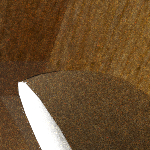Sample-Space Bright-Spot Removal Using Density Estimation
Graphics Interface 2011, St John's, New Found Land (Canada)
Abstract
Rendering images using Monte-Carlo estimation is prone to bright spots artefacts. Bright spots correspond to high intensity pixels that appear when a very low probability sample outweighs all other sample contributions. We present an average estimator that is robust to outliers, which detects and removes samples that are considered as outliers, and lead to bright spots in images computed using Monte-Carlo estimation. By progressively building a per-pixel representation of the luminance distribution, our method is able to delay samples whose luminance is considered as an outlier with respect to the current distribution. This distribution is continuously updated so that delayed samples may be re-considered as viable later in the rendering process, thus making the presented approach robust. Our method does not suffer from blurring in high-frequency zones. It can be easily integrated in any Monte-Carlo based rendering system, used in conjunction with any adaptive sampling scheme, and it introduces a very small computational overhead, which is negligible compared to the use of over- sampling.

Left: image obtained using our method. Right: image obtained by applying the GIMP despeckle filter on the image obtained using the standard average estimator.
Top: full image, bottom: closeup. Note the amount of blur and the deformations at the edges of the objects added by the GIMP filter.
top
Effective Despeckling of HDR Images
Technical Sketch - SIGGRAPH Asia 2011, Hong Kong, China
Abstract
This sketch presents a fast and accurate method for despeckling HDR images, without adding blur or artefacts. We base our approach on a median-based detection phase coupled to a clustering to keep salient features of the images, and then reconstruct the speckled pixels using a robust version of the gaussian filter.
Important note
The slides describe a more elegant and simpler version of the algorithm presented in the paper. It has less parameters, it is simple to implement and very easy to parallelize, while providing results of the same quality of the method presented in the paper. The slides should be enough to implement this improved method.




First and third: tonemapped version of original HDR image, second and fourth: tonemapped version of despeckled HDR image. Click to see complete images.
top

